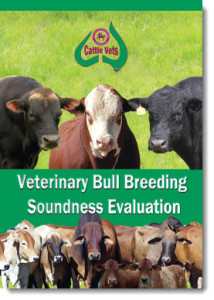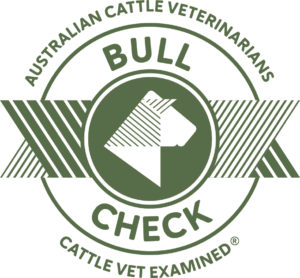BULLCHECK™
Cattle Vets deliver profitability
through BULLCHECKTM
Australian Cattle Vets deliver profitability through accurate advice on bull fertility to beef and dairy industries.
The Veterinary Bull Breeding Soundness Evaluation or VBBSE is a standardized examination developed by the Australian Cattle Veterinarians to identify those bulls at increased risk of being sub fertile. Australian Cattle Vets’ members who have examined over 500 bulls, and passed a practical and theory exam to demonstrate their expertise to their peers can achieve the status of  an “accredited VBBSE veterinarian”.
an “accredited VBBSE veterinarian”.
ACV members have specialised software – Bull Reporter – to record and report on bulls in a standard way. In 2014 we published a textbook describing the Australian standards for VBBSE testing, and all our members have a copy of this publication.
Components of the VBBSE
Australian Cattle Veterinarians recommend that all components of the VBBSE be carried out as this will give you the least risk of having a sub fertile bull. However individual circumstances and requirements vary and you need to discuss this with your veterinarian.
Physical Examination
This entails an examination of the internal and external genitalia, overall structure, gait and scrotal circumference. Findings are reported as either normal/abnormal, on a scale as published in the Australian Cattle Veterinarian Bull Book or as a measurement. If all findings are within normal limits (WNL) then an overall rating of the Australian Cattle Veterinarian tick will be given. If findings are WNL but the vet has some concern of any aspect of the examination a rating of Q is given and the vet will make detailed comments on their concerns. If there are findings that are outside normal limits or abnormal the bull may receive an Australian Cattle Veterinarian X and the vet will make detailed comments so as producers can make an informed decision about the future of the animal in question.
Crush-side Semen Evaluation
Semen is collected from the bull by either manual palpation, electroejaculation or artificial vagina. Individual vets have their preference as to the method semen is collected with, so discuss this with your Australian Cattle Veterinarian prior to examination. Once semen is collected it is assessed grossly for colour, density and contaminants (eg Puss) then microscopic evaluation of gross motility (Mass activity or swirl) and progressive motility. Crush side microscopic evaluation gives an indication of whether the semen will be able to get to the ovum, not whether the semen will be able to fertilize the ovum once there. Some morphological (anatomical) defects can be identified crush side however more detail laboratory analysis is required to give an accurate prognosis.
Crush-side semen is reported using the Tick, Q, X as for physical examination as per Australian Cattle Veterinarian Guidelines.
Morpholgical (Laboratory Examination)
Morphology (anatomy) of the sperm has been shown to be one of the most important indicators of fertility in the bull. Many Veterinarians and researchers believe that morphology is essential to a VBBSE – Carrying out the VBBSE without Morphology is like inspecting a car before purchase but not taking it for a test drive. Research has shown that normal morphology is not only correlated with calf getting ability of the bull but also the maturity and fertility of female offspring. Morphological examination of the semen requires an expensive laboratory microscope and is not generally carried out in the field.
Morphology is reported with the Tick, Q,X and standards are based around the percentage of normal sperm. Individual abnormalities and the frequency will give a prognosis for the bull. Morphology is one of the more controversial issues in the VBBSE. The majority of issues encountered around bull sales are to do with morphology or a lack of. This is because morphology is a very technical science that is not always black and white and morphological findings need to be discussed with your Australian Cattle Veterinarian.
Please note: There is NO SUCH THING as an ACV ACCREDITED morphologist.
Australian Cattle Veterinarians does NOT endorse, accredit or otherwise recommend the services of one morphologist over another. It is up to individual accredited veterinarians to use the services of their selected morphologist or to perform the work themselves (if they choose to).
Serving Ability
Serving ability is a measure of the bulls physical capacity to carry out mating. It is an important component of the Australian Cattle Veterinarian’s bull examination process. It involves observing a bull mounting and mating a female(s). It is often not carried out in Bos indicus bulls as they are considered shy maters that often do not perform when observed or placed under stress.
Summary
The Australian Cattle Vets recommended process for bull examination is not a guarantee that a bull will be good or fertile, however it is an important cost effective tool to reduce the risk of sub fertility in your herd and help improve your profitability.
If you have any further questions please contact your local Australian Cattle Veterinarian’s member.
